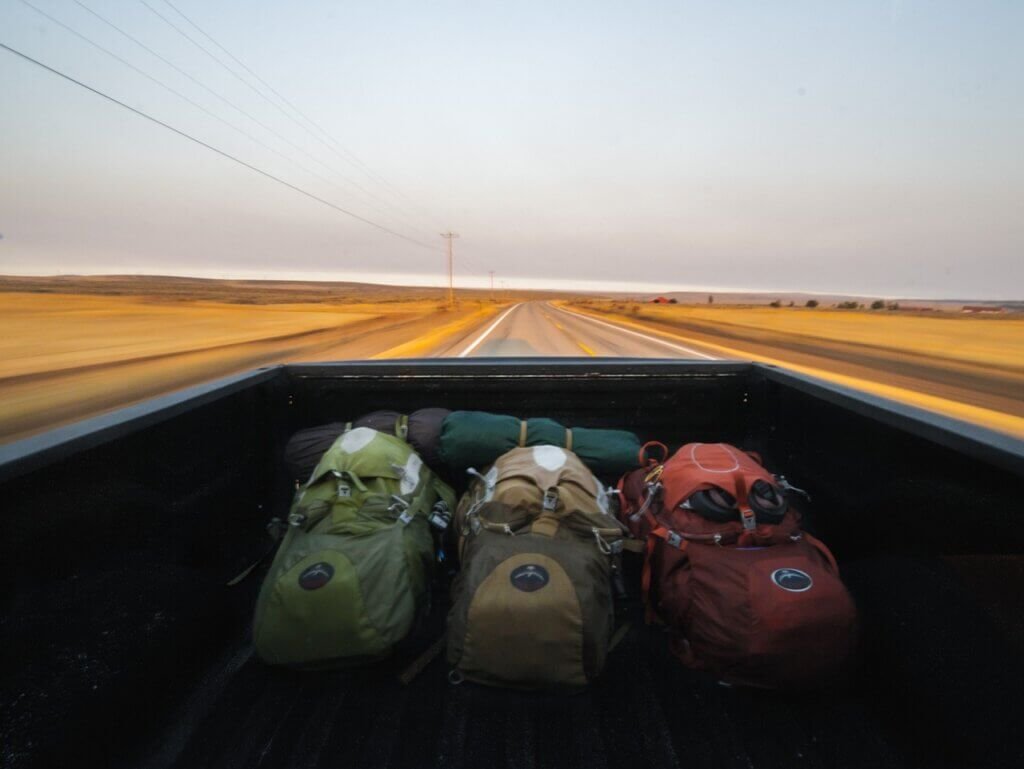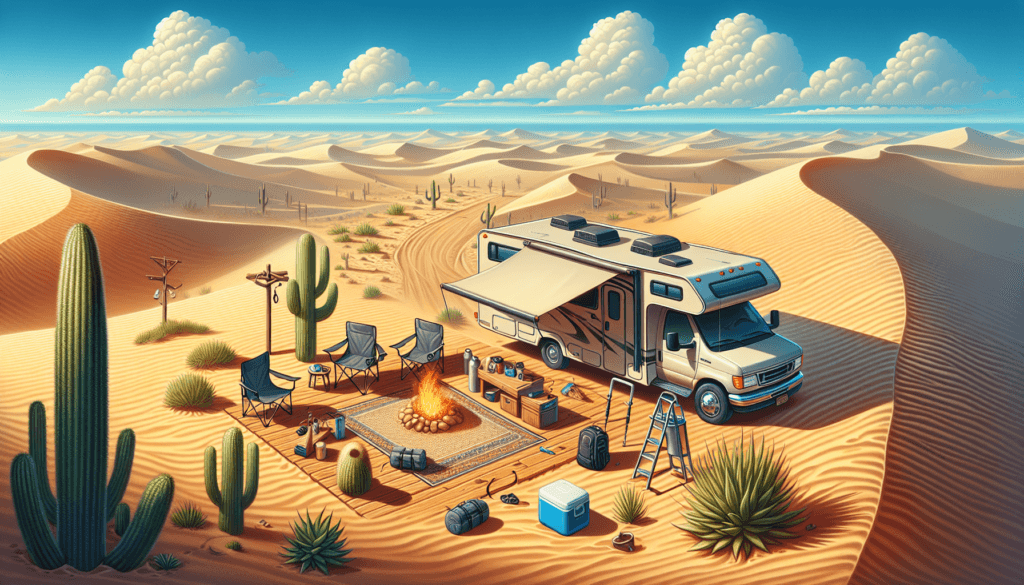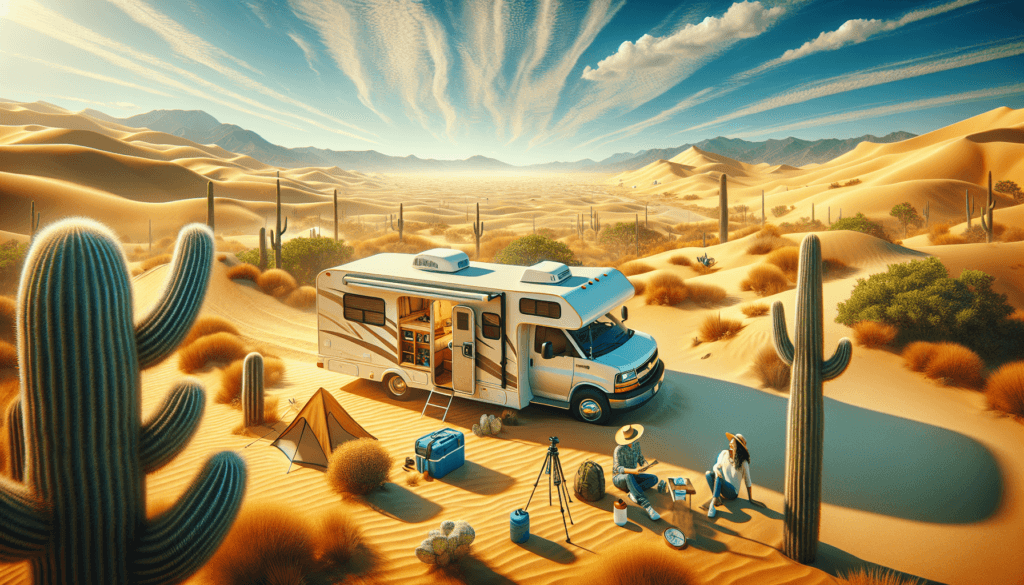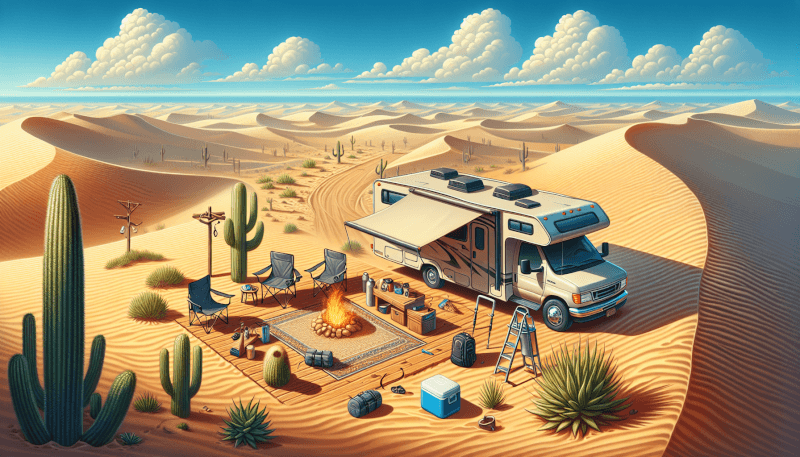Picture this: the sun setting over a vast desert landscape, casting a warm glow on your cozy RV. The peaceful solitude, breathtaking beauty, and endless stretches of untouched nature make RV camping in the desert a truly unforgettable experience. But before you embark on your desert adventure, there are a few key things you need to know to ensure a safe and enjoyable trip. From choosing the right campground to preparing for extreme weather conditions, this article will guide you through everything you need to know for a successful RV camping experience in the desert.

Choosing the Right RV
When planning an RV camping trip in the desert, one of the first things you need to consider is choosing the right RV. The size and weight restrictions in the desert can vary from place to place, so it’s important to ensure that your RV meets these requirements. Look for an RV that is lightweight and compact enough to navigate through sandy or rocky terrain. Additionally, choosing an RV with good insulation is crucial to combat the extreme temperatures in the desert. Look for a well-insulated RV that will help keep you comfortable in both hot and cold weather.
Another important factor to consider when choosing an RV for desert camping is the size of the fresh water tank. The desert environment can be harsh and water sources may be limited. Having a large fresh water tank will allow you to carry an ample supply of water, ensuring that you have enough for drinking, cooking, and washing during your camping trip. It’s also a good idea to choose an RV with efficient water-saving features, such as low-flow faucets and toilets, to help conserve this precious resource.
Lastly, consider the fuel efficiency of the RV you choose for your desert camping adventure. Fuel can be expensive, especially in remote desert areas where gas stations may be few and far between. Look for an RV that offers good mileage and consider alternative fuel options, such as diesel or hybrid engines, to help minimize the impact on your budget and the environment.
Planning Your Route
Before setting off on your RV camping trip in the desert, it’s essential to thoroughly plan your route. Researching the desert areas and their accessibility is crucial to ensure that you choose destinations that are suitable for your RV and travel preferences. Some desert areas may have rough or unpaved roads that may not be suitable for all types of RVs. By conducting proper research, you can ensure that you choose destinations that are accessible and safe for your RV.
Additionally, it’s important to check for campsite availability and make reservations in advance. Desert camping can be popular, especially during peak seasons. By making reservations, you can secure your campsite and avoid disappointment upon arrival. Consider the distance between campsites as well, especially if you plan to explore multiple areas. Ensuring that the distance is manageable will help prevent unnecessary stress and allow you to enjoy your adventure to the fullest.
When planning your route, it’s also essential to take into account the weather conditions and seasons of the desert. Extreme heat during the summer months may make camping uncomfortable or even dangerous, while cold temperatures during the winter months can pose additional challenges. Researching the average temperatures and weather patterns of the desert region you plan to visit will help you pack and prepare accordingly.
Packing Essentials
Packing the right essentials is essential for a successful RV camping trip in the desert. First and foremost, make sure to pack an ample supply of water and food. Dehydration can be a serious risk in the desert, so it’s important to have enough water for drinking and cooking. Additionally, pack non-perishable food items that are easy to prepare and require minimal cooking, as open fires or barbecues may not always be permitted in certain desert areas.
Proper clothing and footwear are also crucial for a comfortable and safe camping experience in the desert. The desert climate can vary from scorching hot during the day to chilly at night. Pack lightweight, breathable clothing for the daytime, but also include warmer layers for the cooler evenings. Don’t forget to pack sturdy footwear that provides good traction and protects your feet from the rugged desert terrain.
When it comes to camping gear, be sure to pack essentials such as tents, sleeping bags, camping stoves, and cooking utensils. These items will ensure that you have a comfortable and functional campsite. Additionally, don’t forget to pack emergency supplies such as first aid kits, flashlights, and extra batteries. The desert can be a remote and unforgiving environment, so it’s important to be prepared for any unexpected situations.
Finally, be sure to pack maps and navigation tools to help you navigate through the desert. GPS systems may not always be reliable in remote desert areas, so having paper maps and a compass can provide peace of mind and help prevent getting lost.
Preparing for Extreme Temperatures
When camping in the desert, it’s important to prepare for the extreme temperatures that can be experienced during the day and night. Understanding the risks associated with extreme temperatures is crucial for your safety and comfort.
Protecting yourself from the heat is essential to avoid heatstroke and dehydration. Make sure to stay hydrated by drinking plenty of water throughout the day. Wearing loose-fitting, lightweight clothing in light colors can help reflect the sun’s rays and keep you cooler. It’s also important to seek shade during the hottest parts of the day and avoid strenuous activities during peak heat hours.
Conversely, you may also encounter cold temperatures in the desert, especially during the winter months or at higher elevations. Pack warm layers, such as sweaters, jackets, and blankets, to keep yourself cozy during chilly nights. You may also consider bringing portable heaters or electric blankets to ensure that you’re comfortable inside your RV.
In addition to protecting yourself, it’s also important to prepare your RV for extreme temperatures. Ensure that your RV is properly insulated to help regulate the interior temperature. Consider using window coverings or curtains to block out sunlight and keep the interior cool. During colder temperatures, using thermal curtains and door draft stoppers can help prevent heat loss and keep your RV warm.

Conserving Resources
Conserving resources is not only important for sustaining your camping trip in the desert but also for preserving the fragile desert environment. By managing your water usage, minimizing electricity consumption, and properly disposing of waste, you can reduce your ecological footprint and enjoy a more sustainable camping experience.
Managing water usage is crucial in the desert, where water sources may be scarce. Take shorter showers, turn off faucets when not in use, and use water-saving features in your RV, such as low-flow faucets and toilets. Additionally, consider using biodegradable and eco-friendly cleaning products to minimize the impact on the environment.
Minimizing electricity consumption is another way to conserve resources while camping in the desert. Turn off lights and appliances when not in use, and consider using solar-powered camping gear and portable solar panels to harness the abundant sunlight in the desert. This not only reduces your reliance on non-renewable energy but also saves on fuel costs.
Proper waste disposal is essential to maintain the cleanliness and natural beauty of the desert. Pack out all trash and waste, leaving no trace of your visit. Properly dispose of gray and black water in designated dump stations or facilities to prevent contamination of the desert ecosystem. It’s also important to avoid littering and respect the environment by not disturbing rocks, plants, or wildlife.
Using solar power is an excellent way to conserve resources while camping in the desert. Solar power can be used to charge your electronic devices, power lights and appliances, and even heat water. Investing in portable solar panels and solar-powered gadgets can provide you with a sustainable and reliable source of energy, regardless of how remote your camping location may be.
Staying Safe in the Desert
When camping in the desert, it’s important to prioritize your safety. Familiarize yourself with the wildlife and potential hazards of the area you plan to visit. Desert wildlife, such as snakes, scorpions, and spiders, may be present, so take necessary precautions to avoid encounters. Be mindful of any rules and regulations regarding wildlife encounters and keep a safe distance at all times.
Navigating unfamiliar terrain can be challenging, especially in the desert where landmarks may be scarce. Make sure to carry a detailed map, compass, and GPS device to help you find your way. Additionally, consider using offline map apps on your smartphone as a backup. Familiarize yourself with any trail or road signage and follow designated paths to avoid getting lost or damaging the fragile desert ecosystem.
In case of emergencies, it’s crucial to have proper communication devices and first aid supplies. Carry a fully charged cell phone and consider investing in a satellite phone or emergency locator device for areas with limited or no cellular coverage. Additionally, pack a comprehensive first aid kit that includes essentials such as bandages, antiseptics, medications, and emergency supplies. It’s also important to share your camping itinerary and expected return date with a trusted friend or family member, so that someone knows where you are and can raise the alarm if necessary.

Finding the Right Campsite
Finding the right campsite is essential for a comfortable and enjoyable desert camping experience. Researching camping options in advance will help you choose a campsite that meets your preferences and needs. Consider factors such as location, accessibility, available amenities, and proximity to attractions or hiking trails.
When choosing a campsite, consider the amenities and facilities that are important to you. Some campsites may offer amenities such as clean restrooms, showers, picnic tables, and fire pits, while others may be more remote and offer a more rustic camping experience. Determine your desired level of comfort and choose a campsite accordingly.
It’s also important to stay on designated campsites to minimize your impact on the environment and wildlife. Designated campsites are typically equipped with proper facilities and amenities, and using them helps preserve the natural beauty of the desert. Avoid camping in undesignated areas, as this can cause damage to the fragile desert ecosystem and disrupt wildlife habitats.
Finally, always remember to respect the environment and wildlife when camping in the desert. Keep noise levels to a minimum, especially during quiet hours, to avoid disturbing other campers and wildlife. Dispose of trash properly and do not feed or approach wildlife, as this can alter their natural behaviors and cause harm to both the animals and yourself.
Tips for a Comfortable Stay
To ensure a comfortable and enjoyable stay during your RV camping trip in the desert, consider the following tips:
- Set up your camp efficiently by choosing a level and stable area. Use leveling blocks if necessary to ensure a flat surface for your RV.
- Creating shade and shelter is essential in the desert, where the sun can be relentless. Use awnings, tarps, or pop-up shelters to create shaded areas outside your RV. Additionally, consider using reflective covers for windows to block out sunlight and keep the interior cooler.
- Managing the temperature inside your RV is key to staying comfortable. Use fans or air conditioning to cool the interior during hot days, and utilize insulation and thermal covers to keep warm during cold nights. Consider using window shades or blinds to block out direct sunlight and reduce heat absorption.
- Making use of outdoor spaces is one of the joys of camping in the desert. Set up a comfortable outdoor seating area with chairs or loungers, and consider bringing a portable fire pit for cozy campfire evenings. Embrace the natural surroundings and enjoy the wide-open spaces and stunning desert landscapes.

Activities and Recreation
Camping in the desert offers a plethora of activities and recreational opportunities. Here are a few suggestions to make the most of your desert adventure:
- Exploring hiking trails and natural attractions is a must-do when camping in the desert. Research nearby hiking trails and choose routes that suit your fitness level and interests. The desert is home to unique and diverse ecosystems, offering stunning rock formations, panoramic views, and the chance to spot desert wildlife and wildflowers.
- Photography opportunities abound in the desert, with its dramatic landscapes, vast open skies, and stunning sunrises and sunsets. Capture the beauty of the desert by documenting its unique features, wildlife, and the play of light and shadows.
- Wildlife watching is a popular activity in the desert. Keep your eyes peeled for desert animals such as coyotes, jackrabbits, roadrunners, and various bird species. Bring binoculars and wildlife guidebooks to enhance your wildlife viewing experience.
- The desert is known for its dark skies, making it an ideal destination for stargazing. Set up a cozy outdoor space, away from artificial lights, and marvel at the countless stars and constellations that light up the desert sky. Consider bringing a telescope or star chart to enhance your stargazing experience and deepen your understanding of the universe.
Leave No Trace
To ensure the long-term preservation of the desert environment, it’s important to practice the principles of Leave No Trace. This means minimizing your impact on the land, wildlife, and other visitors. Here are a few key principles to follow:
- Pack out all trash and waste. Leave your campsite and the desert as you found it, taking everything with you and disposing of waste properly in designated trash receptacles.
- Avoid disturbing wildlife. Observe animals from a distance and refrain from feeding or approaching them. Do not disturb nests, burrows, or other wildlife habitats.
- Keep noise levels to a minimum. Respect the tranquility of the desert and avoid loud noises, especially during quiet hours.
- Respect the natural environment. Do not pick or damage plants, rocks, or other natural features. Leave them for others to enjoy and help preserve the delicate balance of the desert ecosystem.
By following these principles, you can enjoy the beauty of the desert while ensuring its preservation for future generations to enjoy.
In conclusion, RV camping in the desert can be an incredible and memorable experience. By choosing the right RV, planning your route, packing the essentials, preparing for extreme temperatures, conserving resources, staying safe, finding the right campsite, and following the principles of Leave No Trace, you can have a comfortable and enjoyable desert camping adventure. Embrace the beauty and solitude of the desert, explore its unique landscapes, and create lasting memories in this remarkable wilderness.



